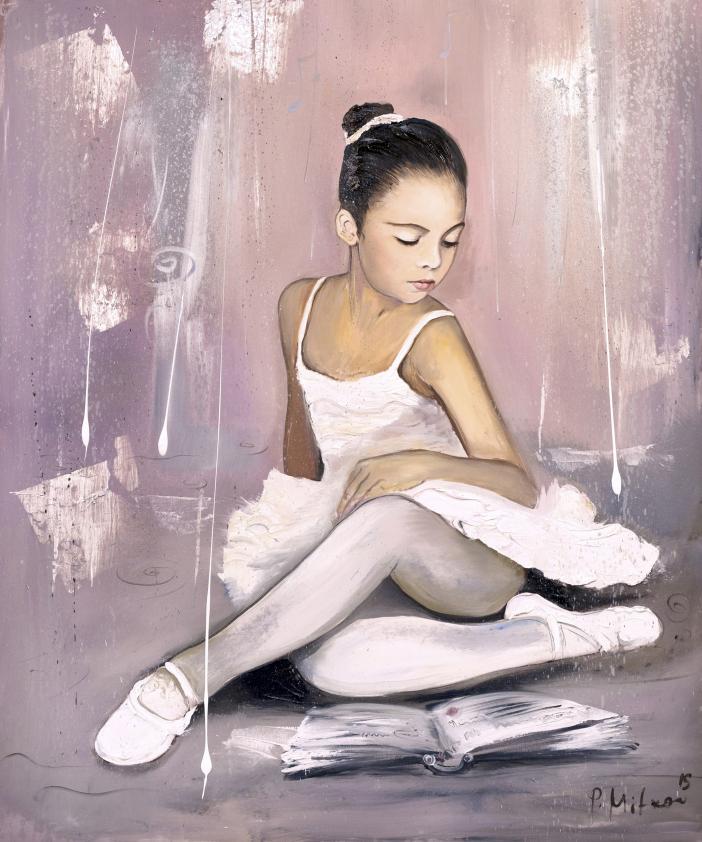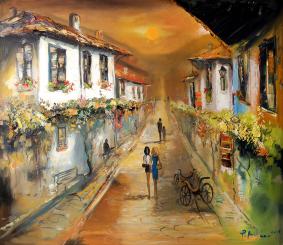Original artwork, 100 x 120 cm, Oil on canvas, 2014
The second part of Pavel Mitkov's Parisian ballet triptych is titled The Secret Book. A title so mysterious and mesmerising – what is in it?
We once again see the character from the first part, but this time she looks a little older.You bet! Studying at a choreography school is always “conditional” - until the first failure and the first moment of weakness. Ballet education is a paragon, model of self-denial for the sake of a higher goal. A young ballerina is expected to complete the general course, to master classical, folk and traditional dances as well as take classes in theatre and ballet history, make-up and many others.
At the bottom of the painting, just below centre, like a base or a pedestal of a kind, an open book lies under the young ballerina's fixed gaze. This is what matters to the artist in this part of the triptych. He spotlights the book and the character's stare, her left arm and shoulder's movement (now more mature and well-defined) and the graceful hard-working ballet legs and feet framing the bottom of the book. The book is not on the desk but on the floor – a ballerina's typical work space rather than a silent library room. With his signature strokes, Mitkov has painted white dashes – 'air' according to colour semantics – thus bringing dynamics to the work area.
The mise-en-scène depth is clearly visible: the floor, slightly slanted, rises to the top corner of the painting like a hill slope. We could only marvel at the artist's knowledge – such a special ballet floor, on the one hand, makes it possible to show dancers to spectators in the most beneficial way and, on the other, the wooden deck lifted above the concrete foundation adds bounce to leaps and reduces strain in ballet dancers' knees and backs.
So, there it is, a book, a powerful and polysemantic symbol, a source of knowledge, a collective and instructive symbol. In the holy scriptures, the book is in the centre of Eden, where it is represented as the tree of life. An open book denotes learning. But what is the secret book? What we see lying before the character is more than just a course-book, or publicise or fiction. It is a secret book which can only be discerned by the initiated. Mitkov's character is most likely studying a ballet notation – the dance move sequence. And it is a secret book indeed, a special kind of “dance script” whose conception dates back to the 15 c. The top two lines show head and torso movements, the middle three lines – arm movements and the bottom four lines – leg and foot positions. There is a special character corresponding to each movement. There is everything there: turns, transitions, orientation. There is every “pas”, every mise-en-scène, all the structure and architectonics of the entire ballet is in it. It is through such secret books that we have come to know today masterpieces such as The Nutcracker, Coppelia, The Sleeping Beauty and Swan Lake. A book on the floor is the first step to a future ballet performance.
Choreology is information and conveying information needs the notion of “symbols”. And very much to the point, Pavel Mitkov has introduced musical symbols on the canvas: the G clef and three notes – two quavers and a crotchet – drawn in blue as a nod to the first part of the triptych. The girl is listening and humming to the ballet music, imagining the pas de chat, then preparation and attitude... Once the “secret book” notation has been examined, it is necessarily studied with a concertmaster, piano accompaniment and even the orchestra conductor attending classes to help develop “a sense of movement”.
For the time being, Mitkov's ballerina is still learning the ABC, learning to read and remember ballet notations and understand the language of the secret book. Difficult it is, and she probably does not get it right every single time. Even her right leg, which does not entirely match the perfectly positioned left one, is only a very appropriate sign of gradual development, polishing and of the idea of transformation, which underlies the first part of the triptych.
Mastering choreographic literacy, the formulas in the secret book, is the underlying foundation for work and for saving knowledge for generations to come. But Mitkov's tiny dancer is hovering above the book as though going to the next level. Having learnt the notation, she is looking for intonation inside herself. This search comes across in the turn of her head, in her facial expression, in the shoulder movement, in the “secret” of her right hand hidden behind her back. For notation intonation is in the very manner of performance. Thus, with simple techniques, Pavel Mitkov adds sophistication to the little ballerina's image. How will the story end?









